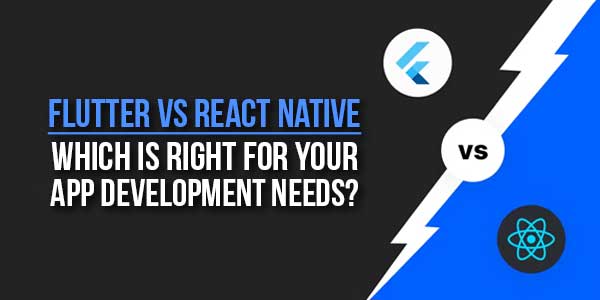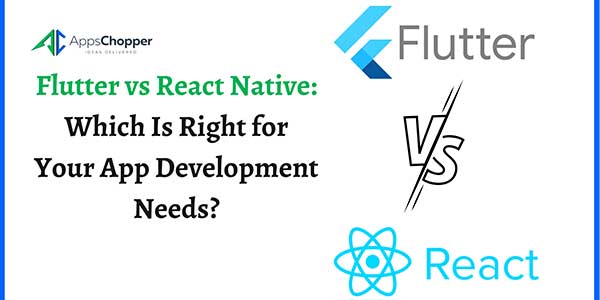
Flutter and React Native are successful in their own right. However, choosing between the two frameworks isn’t trivial because of their significant differences.
Both provide a range of features and advantages, but they differ in terms of performance, development environment, UI components, community support, and more.
In this post, we will run a detailed comparison between Flutter and React Native to help you make the best decision for your project.
Table of Contents
Overview Of Flutter:
Flutter is a framework powered by the Dart programming language. Developers build highly responsive and attractive apps for iOS, Android, and even the web with its help. One of the key benefits of Flutter application development is its impressive performance.
It utilizes a rendering engine that allows for smooth animations and a delightful user experience. Flutter’s “hot reload” feature lets developers see changes as they occur, making the development process faster and more efficient. Developers can create visually appealing apps with customizable UI components and stunning designs.
Overview Of React Native
React Native is a JavaScript framework that uses familiar web development technologies to build native apps. It offers the ability to write code once and deploy it anywhere. It leverages a bridge that communicates between JavaScript and native components, providing access to the device’s features and capabilities.
React Native’s popularity stems from its large developer community and the vast ecosystem of libraries and packages available. This allows quicker development cycles and the ability to tap into existing resources.
Flutter Or React Native: Which Is Better In 2023?
Our list of comparison criteria includes several essential parameters wherein lie the differences between the two popular frameworks. These include the following:
Programming Languages:
One of the primary differences between Flutter and React Native lies in the programming languages used. Flutter uses Dart, while React Native utilizes JavaScript.
Dart is a modern and object-oriented language developed by Google. It offers a strong static-type system, which helps catch potential errors during development. On the other hand, JavaScript is widely known and extensively used in web development, making React Native a favorable choice for JavaScript developers.
Dart is comparatively new and not as highly adopted. However, it is appreciated among the developers that use it because of its low learning curve.
So, you may want to consider React Native if your development team’s skills lie on the JavaScript side. On the other hand, Flutter is an equally good choice if your team doesn’t have prior experience in JavaScript.
Code Structure:
Flutter follows a reactive and declarative programming style, where the entire user interface is created as a widget tree.
That said, code in Flutter can only be shared on Android and iOS.
Despite more complex code, React Native allows developers to share it across more platforms. Therefore, they have to worry less about compatibility issues when writing code.
Documentation:
Both Flutter and React Native offer comprehensive resources in this regard. Flutter provides extensive documentation on its official website, including tutorials, guides, and API references.
The Flutter community actively contributes to the documentation, ensuring developers can access up-to-date information. So far React Native app development services are concerned, it comes along with detailed documentation and benefits from a large and vibrant community, constantly updating and improving available resources.
However, Flutter’s documentation is simpler, more efficient, and makes the developers’ jobs easier compared to React Native’s documentation.

User Interface:
The user interface plays a crucial role in the success of any mobile application. Flutter excels in this aspect with its customizable and visually appealing UI components. It uses a rich set of customizable widgets called the Flutter Widget Framework. It allows developers to create visually appealing and highly interactive interfaces.
React Native takes a different approach by using native UI components specific to each platform. It allows developers to leverage the platform’s native UI elements, resulting in apps that look and feel native. This approach gives React Native an advantage regarding platform-specific features and performance. Its community-contributed UI libraries offer varying pre-built components for fast, simple development.
Time-To-Market:
Development time is often a critical factor in app development. For instance, the ‘hot reload’ feature allows Flutter app development agency programmers to view changes instantly without restarting the app when working on a project. This, furthermore, significantly reduces development time.
This feature provides a smooth and iterative development experience. React Native also offers hot reload functionality, enabling developers to see real-time changes quickly. Both frameworks prioritize developer productivity and contribute to faster development cycles.
Performance:
When it comes to performance, Flutter has the advantage of rendering its UI directly on the device’s canvas, resulting in fast and responsive applications. The compiled Dart code eliminates the need for a JavaScript bridge, enhancing performance further. React Native, on the other hand, relies on native components and leverages a JavaScript bridge for communication. This can introduce some overhead.
Testing And Deployment:
Both Flutter and React Native offer robust testing capabilities. Flutter comes with a built-in testing framework called Flutter Test, allowing developers to write unit, integration, and widget tests. It provides tools for automated testing and supports popular testing libraries. React Native utilizes testing tools like Jest and Detox, enabling developers to write comprehensive tests for their applications.
API Capabilities:
Flutter and React Native provide access to various device APIs, allowing developers to integrate native functionalities into their applications. Flutter’s extensive plugins enable seamless integration with device features like cameras, geolocation, and sensors. The Flutter community actively contributes to developing plugins, ensuring a wide range of options.
Hot Reload:
Flutter’s hot reload feature allows developers to see their real-time changes, eliminating the need for time-consuming compile and deploy cycles. This iterative development process accelerates development speed and reduces time-to-market. Additionally, the code reusability offered by Flutter reduces the overall development effort, resulting in cost savings.
React Native also offers fast development cycles with its hot reloading capability. However, it may require additional time for optimizing performance and resolving platform-specific issues. Its code reusability across platforms can help reduce development time and cost, especially when building apps for iOS and Android simultaneously.
Community Support:
This is a crucial factor when choosing a framework. Flutter has gained substantial popularity and has a growing community of developers. It actively contributes to open-source projects, provides support through forums and chat groups, and organizes events and conferences.
React Native, being older and more established, has a larger community and a vast ecosystem of resources. This robust ecosystem ensures that any React Native app development agency has access to a wealth of knowledge, tutorials, and support when working on a client project.
Flutter VS. React Native: The Verdict:
We’ve compared these top-rated technologies based on every important criterion from development and business perspectives. Choosing React Native or Flutter app development services all boils down to your specific requirements.
Flutter offers impressive performance, a fast development cycle, and a rich set of customizable UI components. It excels in code reusability, provides extensive documentation, and has a growing community.
On the other hand, React Native leverages native components, allowing for platform-specific features and optimal performance. It benefits from a bigger, more established community with a vast ecosystem of resources and libraries.

 About the Author:
About the Author:
















Be the first to write a comment.